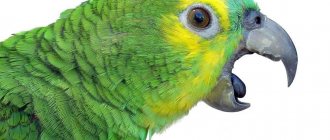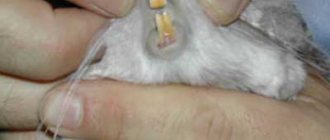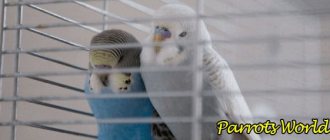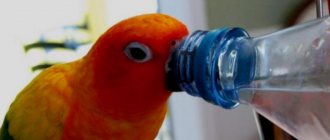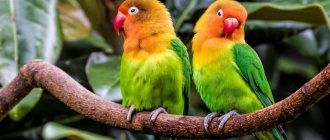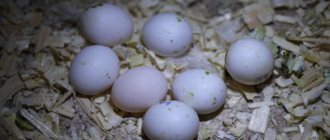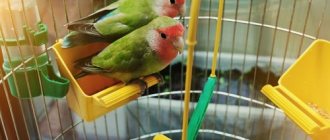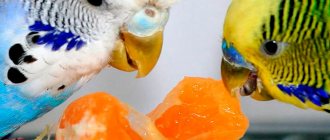Gaining the bird's trust
Budgerigars are quite easy-going in nature; they easily get used to new owners. Even an aggressive and sometimes cowardly parrot, over time, easily makes contact and behaves friendly. After all, winning the trust of feathered beauties is sometimes not so difficult. The easiest way to get a truly faithful friend is if the parrot was brought up to you very young. However, there are situations when the bird behaves aggressively, disobediently, and specifically tries to peck.
It doesn’t matter whether it’s a defensive reaction from a feathered friend or an ambitious method of intimidation - no one wants to lose trust and get bitten by their own winged pet.
Here's what might be causing this behavior:
- Puberty is one of the reasons why the wavy can show aggression. In this case, it is temporary.
- If a bird feels a lack of attention to itself, an attempt to peck will not just be a way to attract attention, but also a way to assert itself.
- Shedding. At this time, the bird is stressed. Aggressive behavior is not always justified, but this is how anxiety, agitation and irritability manifest themselves.
Also, a budgerigar may behave early in the morning if the bird was woken up at the wrong time, or if the feeding procedure was carried out too late. The blame for everything is dissatisfaction.
Budgerigars are social birds, and it is not difficult to win their love and tender feelings. But this requires time, endurance and, most importantly, reciprocity.
It is necessary to find out the reason for this behavior and build an algorithm for behavior in an unpleasant situation.
Is aggressive behavior considered deviant?
In nature, parrots use their beak not only when communicating with other individuals, but also for cracking nuts and eating food.
They use it when climbing trees, but rarely use it for defense or attack. Typically, aggression in the natural environment is presented in the form of screaming and flapping its wings.
For parrots living in captivity, the beak is an effective weapon for protection from strangers , other pets or unpleasant relatives. If a pet has bitten a person severely, you should not scream, swear, or click the bird’s beak, as this will cause even greater aggression, and will also make it difficult to tame.
The bites of an aggressive wavy are not a slight tingling, but a full-fledged rupture of the skin, and therefore can lead to serious injuries.
If a bird behaves calmly in front of strangers and does not try to bite a person, then this is considered a bad sign. Usually this indicates the presence of some serious diseases, so the bird simply does not have the strength to show aggression and defense. Weakened individuals become apathetic and calm, so their behavior reveals health problems.
Is your parrot tame?
Not really
How to tame a parrot: hand-feed
An attempt to tame a parrot through treats encourages you to position the bird “correctly” and teaches you to respond adequately to your hands and your interference in your “personal” space. After all, most often a parrot becomes aggressive if the owner tries to do something inside the bird’s house, touches food or toys.
The bird must get used to your hands and feel your friendly attitude. Most often, experienced parrot owners advise starting to feed him with a spoon, and later try feeding him by hand.
Shedding or illness
When a pet feels unwell, it does not want to have contact with a person. If the bird is in this condition, it is better not to disturb it, otherwise you may get a painful bite.
Owners of parrots often notice how birds become more aggressive during the molting period. This is explained by the fact that during the appearance of new plumage, the pet’s skin is very itchy. During this period, it is not recommended to pester him to avoid unpleasant consequences.
We teach you to sit on your finger
The parrot must learn to respond painlessly to hands:
- Behave calmly and do not make sudden movements when trying to train your parrot to sit on your finger.
- Speak peacefully and quietly.
- Try to give your pet the opportunity to get used to your hands - conduct classes daily.
- When you try to bring your finger closer to the bird, lightly stroke the chest and legs of your feathered friend.
It is best to tame a parrot during the day, and not in the evening. Don’t rush into hand training – consider the bird’s mood.
Taming the cockatiel
- For the first couple of weeks, you should not enter the bird’s cage, except when adding food and changing water.
- Teach your cockatiel the command “no!” or use an alternative signal - a soft clap of your hands, which will indicate her bad behavior.
- It is important to be able to recognize the sounds a bird makes. To demonstrate a joyful or aggressive mood, the cockatiel uses signals that differ from each other. Seeing that your pet is ready to attack, imitate the sound of irritation.
- Sometimes a weak click on the beak is enough to put the pet in its place. But such physical influence does not always lead to a positive result. In some cases, this method causes aggression in the bird and provokes more active actions.
- You can stop your cockatiel from biting with a stream of water. To do this, you will need a syringe with liquid, which is used in cases where the pet does not correct itself well.
HOW TO TRAIN A PARROT TO BITE? educational video
We find out what we don’t like and what makes us bite
You cannot change the character of a pet, but it is not at all difficult to simplify your relationship with your bird. Whether a parrot bites or not depends not only on the mood and character of the pet, but also on the situation and circumstances.
Biting is not always aggression, it is also a way of communication.
- If a parrot bites in a cage, this is a normal defensive reaction; the bird is protecting the territory. The feathered one can be distracted by various wooden toys - then he will be able to bite to his heart's content without harming anyone. Any parrot should always have wood and high-quality wooden toys.
- The bird can behave intimidatingly and throw itself into the hands if the owner puts his hand into the cage and tries to take food - this is a defensive reaction.
- Birds can especially often injure their fingers and hands during the breeding season (during laying).
- The bird can defend itself when embitterment has become an acquired character trait. For example, if the parrot came to you as an adult, and the previous owners did not show proper love and care (perhaps they swung at the bird, threw something in its direction, shouted loudly).
- Young parakeets may bite as part of an attempt to gain interest or to explore the world around them.
Reasons why a bird bites
Why the parrot became aggressive and bites - some bird owners think when faced with negative behavior of their pet. And the reasons may be different. These include:
- Fear and stress. Subjected to imaginary aggression, the bird begins to actively defend itself and painfully pecks the “attacker.” This situation is especially common during the period of adaptation to a new place of residence.
- Disease. A sick pet expresses its negative reaction to importunity in this way.
- Boredom, attempts to attract attention.
- Molting or mating games. During such periods, the behavior of pets changes and it is better not to disturb them.
- Expressing dislike or disagreement with someone's actions.
- Property protection. If the owner tries to remove a favorite toy or some treat from the cage, the bird may peck at it. The instinct of ownership is inherent even in parrots.
- Acquaintance. Light nipping is a unique method used by a parrot to get to know its owner better.
- Curiosity. In their natural environment, parrots try with their beak everything that seems interesting to them. They did not lose this trait even in captivity.
Why does the female peck the male?
Why does a female budgerigar peck at the male? - some budgerigar owners think when looking at family squabbles in the cage. In fact, this situation is not uncommon in other parrots. There may be several reasons for its occurrence:
- The female is sick and actively does not want the male to approach her. Usually the disease manifests itself in general lethargy and apathy of the bird. In such a situation, it is necessary to take the female for examination to a veterinarian.
- The female is not in the mood. In this case, moving the male away for a while may help. The girl will calm down and accept the boy into the house again.
- Jealousy. Both boys and girls can be jealous of each other, both towards other birds and towards the owner. In this case, the latter needs to show severity and start issuing prohibiting commands. If the female is well trained, she will understand them.
- The married couple did not work out.
How to stop a parrot from biting your fingers: useful tips
How to teach a parrot to be flexible, tame his temper and get a friendly friend, not a bully?
- First of all, experts recommend that in case of a bite, use a commanding voice to “pull back” the bird. Socialization of parrots allows them to respond adequately and consciously to the intonation of the owner. With this behavior you teach the parrot to respond to “commands”. Over time, the bird will begin to encourage its owner with a response to the word “no” - the parrot will not do anything that will cause a rise in its voice and your indignation.
- Respect the bird. Do not interfere in her “space”, do not encroach on the pet’s territory unnecessarily. Quite adequate aggression in a parrot when the owner tries to clean the inside of the cage, touches toys and removes food - the usual defensive reaction of the wavy also manifests itself through a bite.
- Give us freedom - sometimes let the bird fly. This is the basis of equal friendly relations.
And one more very important nuance is the quality of life of the bird. Normal living conditions that are close to natural definitely help to avoid such unpleasant situations.
Home protection
If a bird notices a hand in its cage, it perceives it as a direct threat. The pet does not recognize the finger, but sees a hostile subject who is furiously encroaching on its territory. Through aggressive actions, the bird protects its home from unwanted interference. When your pet is alone or resting in a cage, do not interfere with it. Food and water can be replaced at other times.
Read also
The parrot crows and hides its head in feathers
Problems arising when using mild forms of punishment
Fighting natural behavior
The use of even mild forms of punishment used during parrot training must be very careful and carefully thought out. First of all, you should think about the very nature of the behavior whose frequency you hope to reduce. There is no point in fighting behavior that is natural to birds. For example, the notorious dawn ceremony of cockatoos. Or the frustrating daily marathon of “who can throw the most trash out of the trough.” Perhaps the transformation of a soft-tempered bird literally into a hungry shark when you dare to put your hand into its cage.
If you lack a creative approach, then the entire responsibility for the bird’s behavior that is unpleasant to you, and sometimes even annoying, lies on your shoulders. For example, you can take a shower while your bird is watching the sunrise. Or install special feeders or shields in the cage, which will significantly reduce the amount of debris that arises due to the way parrots eat so naturally. Feathered sharks can be easily tamed by carrying them outside the cage on a stick, where they will immediately turn into angels.
Causes of problem behavior
You should also think about what might be causing the problem behavior? After all, often the behavior that drives you crazy is just a legitimate expression of protest due to unfulfilled demands. In this case, the strategy you choose should be aimed at satisfying the bird's demands, rather than interpreting its behavior as problematic. For example, it is not typical for birds to scream continuously if:
- They are well fed.
- They have been provided with appropriate living conditions.
- They spend a lot of time outside the cage.
- They are played with their independence in mind.
- Family members devote a certain part of their time to them, and so on.
- How to train, train and tame a parrot using a training strategy?
Lastly, be sure to think about how else you can change your behavior. If it is possible to choose a teaching strategy as an alternative to any punishment, even mild in its form (and based on our experience, such an opportunity is always there), use it. Training strategies have only advantages in taming a parrot. And unlike any form of punishment, they are absolutely safe.
Among their advantages is that they give the bird the opportunity to perform a behavior more often, rather than less often; learn something new, rather than unlearn doing something. It is also an opportunity to live surrounded by praise and develop the confidence that in the presence of a person you can only receive positive emotions. And this is the key to building a trusting relationship between you.
There are many highly effective teaching strategies as an alternative to punishment. For example, two that are worthy of study are a strategy aimed at replacing unacceptable behavior with acceptable behavior or a strategy that teaches behavior that is incompatible with the problem.
Important questions
Essentially, we suggest that you answer three questions before you decide to use one or another mild form of punishment against your parrot:
- Isn't it completely pointless to expect a bird to stop behaving this way?
- Is the problem behavior a result of you not complying with any of the bird's demands?
- When training or taming a parrot, is it possible to use a teaching strategy instead of punishment?
If the answer to any of these three questions is yes, then: forget your vain expectations, comply with the bird's demands and/or use a training strategy that will help you and your bird become best friends forever.
Health problems
When pathologies occur in parrots, they become more aggressive and irritable. These are often the first signs of illness. Why does the parrot bite in this case? Birds cannot tell what is bothering them and are not aware of the exact cause. But the condition worsens, and they begin to chew everything around: cage bars, toys, hands and fingers of their owners. If there is the slightest suspicion of a possible disease, it is better to immediately consult a specialist and either rule out this cause of behavior or immediately begin treatment.
Age: adult bird or chick
Cockatiels are cheerful and cheerful companions. They are very smart and easily learn to speak, perform tricks and simple requests.
As I already mentioned, it would be best to bring home a young chick, who will quickly accept the new environment and make friends with the owner. But the opportunity to adopt a chick is not always given.
Already from the age of one year, parrots find it difficult to perceive innovations and changes in life. Interaction with the bird must be carefully established.
The ways to make friends with a young or adult nymph are not particularly different.
But remember! Those who lived in a pack of their own kind find it difficult to tame. In this case, they prefer communication with their fellow tribesmen rather than with humans.
Curious things about parrots
People don't respect parrots. “Fool ass”, “stupid, you repeat like a parrot” - everyone has heard such expressions. A talkative and noisy bird is associated with stupidity, talkativeness, and arrogance. Is it so?
Dream Interpretation
A parrot appearing in a dream is a warning that the dreamer will face troubles that threaten human dignity and material wealth. But a parrot’s bite makes adjustments to the decoding of dreams. Why do you dream of a parrot bite? Let's turn to dream books for help:
This is interesting: How old is Vitas now in 2018
An ancient dream book. If the dreamer is severely bitten by a beautiful bird, with luxurious plumage, of a noble family (macaw, gray, amazon), the person urgently needs to regain the trust of an influential person. Remember whose favor was lost due to your own indiscretion?
This personality will soon become useful to the dreamer. Hurry to immediately establish contacts and regain trust.
But if a budgie of a simple color bites, be careful! In reality, the dreamer is threatened by human stupidity, leading to an unpleasant situation. It is a good sign if a bird tries to bite while sitting in a cage - this means that the dreamer will disarm the enemy before damage is sustained.
Dream Interpretation Feng Shui. According to Chinese fortunetellers, when you dream of a biting parrot, pay attention to where the bite occurred. The location of the event will tell you what the dream means:
- On the ground - reconsider your surroundings. Enemies hide among friends.
- On the branches of a flowering tree - to the appearance of a charming daughter in the family.
- In the air (during the flight of a bird) - prosperous times lie ahead, without losses or shocks.
- In a cage - get ready for difficulties.
Miller's Dream Book. When you dream that a parrot suddenly began to bite when communicating with a person, this promises idle talk among friends, gossip and unnecessary activities for the dreamer. But if an adult parrot claws at the hand while in a calm (silent) state, a period of peace and prosperity awaits the person in the house.
For a young girl, such a dream foreshadows a marriage proposal from her lover. The bite of a young chick speaks of minor quarrels that will heat up a love relationship.
Rommel's dream book. When an overseas bird bites, expect news from abroad, pleasant news regarding receiving finance (inheritance). Pay attention to how the bird looks: the more luxurious the plumage, the more wealth the dreamer will receive. If blood is visible at the site of the bite, receiving money will take place in a difficult atmosphere. We will have to fight for the right of inheritance.
Interesting facts about parrots
Noisy birds appeared on earth a long time ago. The ancestors of modern parrots differed from the usual pets. During their evolution, modern parrots have lost a lot, but gained even more. Fans of wayward birds will be curious to know about some interesting facts:
- The largest bird of the genus of parrots is the Amazonian. This bird grows up to 1-1.2 meters (the height of a 3-4-year-old human toddler).
- There are also miniature parrots. These species were found in New Guinea (bird size 9-10 cm).
- Parrots are long-lived. Large breeds quietly live to the ripe old age of 100-110 years, while small species live 25-30 years.
- The handsome black cockatoo boasts the largest beak among its relatives. Its length reaches 10-12 cm. It is not for nothing that in translation from Malay the word “cockatoo” means “nippers”. It is better not to anger such a bird - its powerful beak can easily bite a finger.
- But the yellow-cheeked cockatoos are monogamous. Living in a family, these pets choose one owner for themselves. And sometimes a parrot’s favorite is not the person who cares for and feeds them.
- Talkative birds give their chicks individual names. If you have a married couple with offspring, listen. When a bird addresses a baby parrot, the chirping takes on a special sound.
- Parrots, like people, can be left-handed or right-handed. The leading foot of a bird is the one with which the bird takes food.
- Lovebirds are a symbol of a happy marriage; they are famous for the fact that they create only one pair in a lifetime and never quarrel.
- To quickly teach your pet to talk, ask a child or woman for help. Their voice timbre is higher and better remembered by parrots.
Love your talkative pets! Study the habits of birds, psychology, morals. Be sure to control the behavior of birds and correct bad habits! Your efforts will be rewarded and results will come soon. And then the parrot will become a well-mannered, pleasant and affectionate household resident.
Methods
Before you start taming a parrot, be prepared for the fact that for a successful result you will have to spend a lot of personal time. No haste or pressure on the bird is acceptable; any actions should strengthen trust and not destroy it. For the first 2-3 days after the purchase, the parrot is confused and scared, sits silently, is ruffled and quietly sad. This is fine. Leave the bird alone these days.
By nature, parrots are very sociable, so even the most stubborn of them will not sit in the corner of the cage alone for a long time. After a couple of days, the pet will recover a little from stress, will stop rushing to the far corner of the cage when you appear, and will begin to peck food from the feeder when you are in the room. Now you can begin to accustom him to your hands.
Ornithologists suggest following gradual steps in taming.
- First, try to interest your pet in communication. At first, do not come close to the cage and talk to the bird from a distance in an even, soft voice, calling the pet’s name. Then begin to slowly approach the cage so that the bird understands that you are addressing it. Observe your parrot's gestures to see if he is listening to the sounds of your voice. Be prepared to perform this initial stage especially carefully, show maximum patience and do not rush to move on to more active actions.
- Through observation, determine what your parrot likes to eat most. See what he chooses from the feeder first (grain, fruit, nuts, something else). During taming, do not put this food in the feeder, but use it as a treat to encourage the parrot during training.
- For the first time, try to grab just a little bit of your favorite food with your fingers in a pinch and offer it through the bars of the cage. There is no point in opening the cage door and rushing to put your hand inside - the parrot is not yet ready for this. Most likely, he will not take food the first time even through the bars. Don't insist, wait a few minutes and move away from the cage. Offer the treat a second time before feeding again. Perhaps a hungry bird will take a treat. As soon as this happens, praise him in a kind voice and additionally reward him with a treat. Do this step several times.
- After about a week, you can offer treats by hand through the door. Place the treat in your open palm and wait. Calmly continue talking to the bird, don’t rush it, don’t try to convince it to eat the “yummy” food. Wait until the pet decides to approach the hand. This should be done in the morning, when the parrot is alert and hungry. There is no need to extend your hands far into the cage, since at first all parrots are afraid of hands, but this will pass. Do this patiently every day.
- The moment will come when the bird itself will take food from the palm. First, he will grab a grain or nut, bounce from the hand to the far corner of the cage and enjoy the treat in a safe area. Remain calm, do not be nervous, once again be patient and do not scold the bird under any circumstances. The parrot will soon understand that there is no danger, you are not trying to take away the food or grab it. After some time, he will boldly sit in your arms and enjoy the treat without moving deeper into the cage.
- Now you can train your bird to sit on your finger. Place your outstretched finger on the perch where your pet likes to sit. Usually this is enough - the parrot itself jumps onto the finger. But sometimes he simply does not understand what is needed from him. Touch the feathers on the belly in front between the legs, and the parrot will quickly sit on your finger.
We invite you to familiarize yourself with the Budgerigar - a talkative tenor. Description and photo of budgerigars During the training process, it sometimes happens that some parrots cannot be tamed. Don’t deviate from your plan, find another way to interest the bird. You can try to accustom your pet to your hand using a small mirror. Quietly move the mirror in front of the bird, bringing it closer to your open palm and moving it away from the bird.
Special care is required on your part. No sudden movements or hasty gestures, do not risk losing trust. Instead of a mirror, there may be another object - a pen cap, a bottle cap, a new toy - parrots love to tinker with such things. If you manage to find an object that interests the bird, the rest will depend on your desire for success, the sequence of your actions, and everything will certainly work out.
Behavior and character of domestic cockatiels
Corellas are very sociable and intelligent birds. They can charm a person with their cheerful nature, love and friendly communication. This parrot loves to be in the company of its owner. Therefore, quite often a cockatiel or a nymph (another name for the same parrot) can be seen on the head or shoulders of its owner. This parrot shows its mood, ranging from happiness, curiosity, fear, illness or sadness, with the help of a crest above its head.
It is not easy for a new owner to immediately understand the character and behavior of his cockatiel. The best way to figure this out is observation. Take a closer look at your pet, note how he behaves in a given situation. After some time, you will begin to understand the behavior of the cockatiel by external signs. Then it will not be difficult for you to determine what the parrot wants. Cockatiels have a very playful character and active behavior. Head bobbing, beak scratching and rubbing, hanging upside down and tail wagging are some of the common behavioral characteristics you may notice in your budgie. The article describes what the behavior of a male or female cockatiel parrot may be like.
